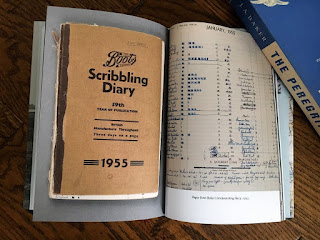Six years ago I wrote about The Peregrine (1967) and its elusive author, J. A. Baker. I was prompted in part by the airing of a radio play about him, written by Helen MacDonald. The book she subsequently published, H is for Hawk, contrasts T. H. White's The Goshawk (1951) with Baker's bleaker vision, his 'awful desire for death' disguised as an elegy for the peregrine. I also referred to a new edition of Baker's complete works, edited by John Fanshawe, which included the diaries used as source material for The Peregrine. Fanshawe has been chiefly responsible for assembling the Baker archive at Essex University and in Robert Macfarlane's recent book, Landmarks, he describes the experience of encountering this collection of notebooks, manuscripts, annotated maps and binoculars. One more thing I mentioned in that earlier post, an album by Lawrence English, is described in an appreciation of Baker, written earlier this year by Robert Macfarlane to mark the fiftieth anniversary of The Peregrine. Apparently, English sent a copy of The Peregrine to Werner Herzog, who was gripped by it:
'Herzog describes The Peregrine as inducing “ecstasy” in the radical sense of the word: not just entranced or frenzied, but literally beside oneself. There are moments, he notes, “where you can tell that [Baker] has completely entered into the existence of a falcon. And this is what I do when I make a film: I step outside of myself into an ekstasis; in Greek, to step outside of your own body.” ... The puzzle to me, for years, was why Herzog had not yet filmed The Peregrine. In 2015, I wrote to ask if he was planning to do so. “If anyone can, it should be you,” I said. I sent him a photograph of my local peregrine perched on a church spire, part-gargoyle. Herzog replied within a few hours, generous about my own writing on Baker, but adamant about the book’s adaptability: “A feature film would be very wrong. There are texts that should never be touched. Georg Büchner’s Lenz is one of these cases. In fact, whoever tries to make a feature film of The Peregrine should be shot without trial.”This story got retold at an LRB Bookshop event last Wednesday. The event was compèred by the sans pareil Gareth Evans and featured John Fanshawe, Robert Macfarlane and his former student, Hetty Saunders, who got inspired by Baker after taking a course on post-pastoral literature. She has catalogued the Baker archive and written a fascinating short biography based on what can be gleaned from it. This book, My House of Sky, includes an evocative selection of archive photographs that take you directly into Baker's world (these pages, incidentally, reminded me of Nick Drake: Remembered for a While, which also reproduced archival material on another intriguing cult figure from the late sixties). Here is just one example of these pages, a bird watching diary from 1955, the year after J. A. Baker first saw a peregrine falcon.
The archive features a set of photographs that were taken of J. A. Baker's bookshelves. Only one is included in the biography, along with a brief list of authors he is known to have read (J. G. Ballard is mentioned, but no specific titles). However, the archive refers to a catalogue John Fanshawe made from the photographs and this can be found online at the Essex University Special Collections website. His spreadsheet has gaps - for example, he lists as a blank what looks to me, from the indistinct image in My House of Sky, to be the spine of Arthur C. Clarke's Four Great SF Novels (I'm not certain of this identification, but I did spend my youth hunting for SF novels rather than goshawks and peregrines...) The Ballard books are in the spreadsheet, although not all are named; there were quite a few, from The Drowned World through Crash to Empire of the Sun. However, aside from these there aren't any startling titles that stand out and the collection is largely as you would expect. I was slightly surprised in the LRB Bookshop talk when Robert Macfarlane likened Baker to H.D and the Objectivists - there's no evidence in this list of him reading these or any other post-Poundian poets.
My House of Sky also includes photographs of the annotations Baker made to proof-copies of his books, returning to them after they were published to study the effectiveness of his prose. There are two pages from The Hill of Summer (the less-successful second and final book that he published), showing where he marked metaphors and similes and counted up the verbs and adjectives. As these are landscape descriptions, it seems fitting to conclude a post on this blog with an example. Here is the first paragraph of 'May: the Pine Wood', showing Baker's 'M's, 'S's and underlinings.
'The pine wood hides the sun, like a dark northernS god rising in menaceM above the white road that falls steeply to the west, and the small green hills beyond are recedingM into a grey autumnal haze. The high town silvers in sunlight, and its sky is barbed with curvingM swifts. But already the night's simplicity is settling uponM the valley. Under the exoticM flowering of the early lights, a blue Venetian duskM laps at the windows of the shadowed houses. As I watch, the high townM is extinguished, and its shiningM sky ascends. The stiff-featheredM pines shed their darkness into the still air.'


No comments:
Post a Comment